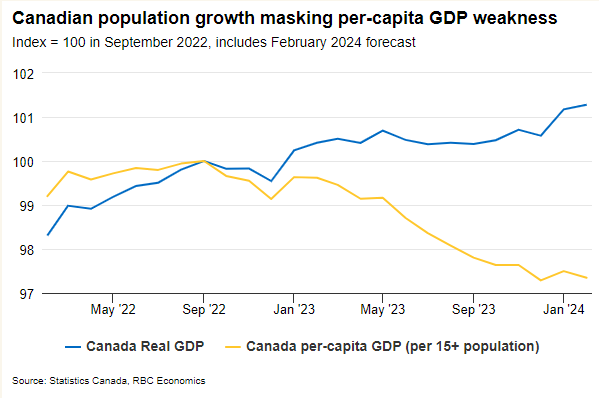On Tuesday, we expect Canadian gross domestic product in February to show a more subdued 0.1% increase than the 0.6% jump in January and below the 0.4% advance estimate released a month ago.
The surge in January output was in part tied to transitory factors that will not happen again. Half of the increase came from a rebound in the education sector following the end of large public sector strikes in Quebec. Early data is pointing to a large increase in oil production in Alberta in February, but a weather-related lift in utility output in January is expected to partially reverse. Manufacturing sale volumes edged up just 0.1% in February. Retail sale volumes declined by 0.3% and home resales pulled back 2.6%.
We expect the early flash growth estimate for March to also look soft. Our RBC Consumer Spending Tracker suggests real retail sales declined in March alongside a rise in the unemployment rate and tick lower in hours worked. Fading economic growth momentum late in the quarter, particularly when measured against further rapid population growth, should add to evidence that the underperformance of the Canadian economy relative to other regions is continuing. It’s consistent with our assumption that the Bank of Canada will shift to interest rate cuts before mid-year.
U.S. Federal Reserve policymakers are seeing a very different economic backdrop ahead of next Wednesday’s interest rate decision. U.S. consumers continue to boost spending despite higher interest rates and inflation pressures have shown concerning signs of reaccelerating. The Fed is widely expected to hold the federal funds rate unchanged next week. The language in the policy statement is likely to flag fewer interest rate cuts this year than the 75 basis points worth of declines expected by the policymakers in March. U.S. weekly jobless claims are holding at low levels, suggesting that labour market data on Friday will continue to look firm and reinforce that there is less urgency for the Fed to start pushing interest rates lower than there is for the Bank of Canada.
Week ahead data watch
March Canadian trade data will likely show a widening trade surplus, up by $1 billon from February. Higher oil prices will boost the energy trade balance. Imports are expected to decline 1.4% on lower motor vehicle shipments and railway carloadings with exports remaining little changed from February.
The U.S. goods trade deficit widened by US$1.5 billion in March in the advance U.S. international trade report. Exports and imports of goods slipped during the month by US$6.1 billion and US$4.6 billion, respectively. We think the overall trade deficit stood at US$68.8 billion.
We expect April U.S. jobs numbers will remain strong with a 267,000 jump in payroll employment, adding to the 303,000 jump in the previous month. We look for the unemployment rate to hold steady at 3.8%.
